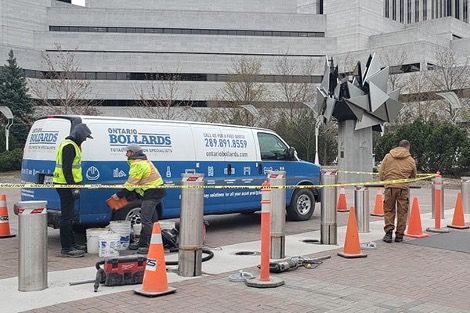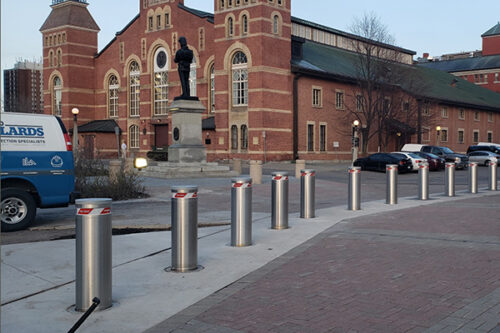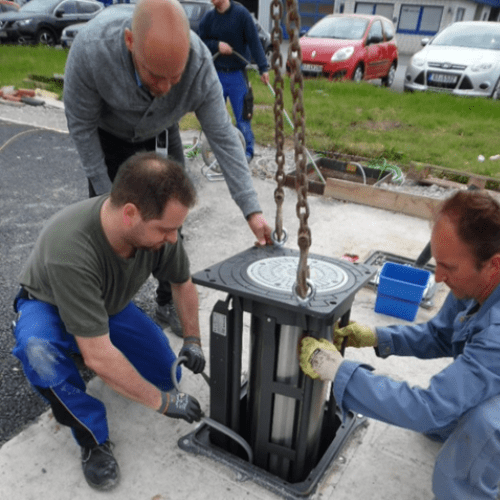Crash-Rated Bollards: Essential Protection for Safer Public Spaces
Quick Summary
Crash-rated bollards are engineered security barriers that protect pedestrians and infrastructure from vehicle impacts—both accidental and intentional. These robust barriers undergo rigorous testing to withstand high-speed collisions, making them essential for safeguarding public spaces, commercial properties, government facilities, and critical infrastructure across Ontario. Beyond their primary safety function, crash-rated bollards contribute to organized urban design and can enhance aesthetic appeal when properly integrated.
What Are Crash-Rated Bollards?
Crash-rated bollards represent a significant advancement over standard bollards in security infrastructure. These specialized barriers undergo extensive testing and certification to ensure they can stop vehicles traveling at high speeds, effectively protecting people and property from vehicle-borne threats.
Key Engineering Features:
- High-strength steel core construction with reinforced concrete foundations
- Energy absorption technology that dissipates kinetic force upon impact
- Third-party tested and certified to meet ASTM and DOS standards
- Deep foundation systems engineered for maximum stopping power
Why Public Space Safety Demands Crash-Rated Protection
In today’s urban environments—from Toronto’s city centers to Ottawa’s government districts—ensuring pedestrian safety has become paramount. Crash-rated bollards serve as the last line of defense against vehicle incursions, whether from distracted drivers or deliberate attacks.
Critical Safety Benefits:
- Prevent accidental vehicle intrusions into pedestrian zones
- Mitigate security threats from intentional vehicle attacks
- Create clear visual boundaries between vehicular and pedestrian areas
- Provide psychological reassurance to visitors and employees
The Science Behind Crash-Rated Bollard Performance
Understanding how crash-rated bollards work helps facility managers and security professionals make informed decisions. When a vehicle impacts a crash-rated bollard, the kinetic energy transfers through the bollard’s structure into its deep foundation system, where it dissipates harmlessly into the surrounding substrate.
Industry Testing Standards:
ASTM F2656-07 Classifications:
- M30: Stops 15,000 lb vehicle at 30 mph
- M40: Stops 15,000 lb vehicle at 40 mph
- M50: Stops 15,000 lb vehicle at 50 mph
DOS K-Rating System:
- K4: Stops 15,000 lb vehicle at 30 mph
- K8: Stops 15,000 lb vehicle at 40 mph
- K12: Stops 15,000 lb vehicle at 50 mph
Types of Crash-Rated Bollards for Different Applications
Selecting the appropriate bollard type depends on your specific security requirements, site conditions, and operational needs. Ontario Bollards offers several configurations to meet diverse security challenges:
Fixed Bollards
Permanently installed barriers providing continuous, uncompromising protection. Ideal for:
- Government building perimeters
- Critical infrastructure boundaries
- High-risk pedestrian zones
Removable Bollards
Offer security flexibility with the ability to create temporary access when needed. Perfect for:
- Event venues requiring periodic vehicle access
- Emergency vehicle routes
- Seasonal pedestrian areas
Retractable Bollards
Automated or manual systems that rise from ground level when activated. Optimal for:
- Corporate campuses with controlled access
- Mixed-use developments
- VIP entrance points
Decorative Crash-Rated Bollards
Combine aesthetic bollard designs with crash-rated protection for:
- Historic districts
- Upscale retail environments
- Architectural showcase areas
Key Benefits That Justify the Investment
1. Life-Saving Protection
The primary benefit remains clear: crash-rated bollards save lives by preventing vehicles from entering pedestrian spaces. This protection extends to both accidental incidents and intentional attacks.
2. Liability Risk Reduction
Property owners and municipalities face increasing liability for pedestrian safety. Installing certified crash-rated bollards demonstrates due diligence in protecting public welfare.
3. Urban Design Enhancement
Modern crash-rated bollards integrate seamlessly with landscape architecture, contributing to attractive, well-organized public spaces while maintaining security.
4. Long-Term Cost Effectiveness
While initial investment is higher than standard bollards, crash-rated systems offer superior durability and reduced replacement costs over their lifecycle.
Real-World Applications Across Ontario
Government Facilities
Federal buildings, courthouses, and municipal offices require the highest level of perimeter security. Crash-rated bollards protect against vehicle-borne threats while maintaining accessibility.
Transportation Infrastructure
Airports, train stations, and bus terminals use crash-rated bollards to separate vehicle traffic from pedestrian queuing areas and terminal entrances.
Commercial Properties
Shopping centers, office complexes, and retail storefronts benefit from crash-rated protection at building entrances and outdoor dining areas.
Public Venues
Sports stadiums, convention centers, and festival grounds employ temporary and permanent crash-rated bollards for crowd protection during events.
Critical Infrastructure
Power plants, water treatment facilities, and data centers require crash-rated perimeter security to protect essential services.
Navigating Regulatory Compliance and Standards
Compliance with recognized testing standards ensures your crash-rated bollards provide reliable protection:
Essential Certifications:
- ASTM F2656-07: The North American standard for vehicle barrier testing
- DOS K-Rating: U.S. Department of State anti-ram vehicle barrier standards
- CSA Standards: Canadian-specific requirements for public safety barriers
Local Compliance Considerations:
- Municipal bylaws regarding sidewalk installations
- Heritage district restrictions on bollard aesthetics
- Accessibility requirements under AODA guidelines
Selecting the Right Crash-Rated Bollard System
Making the optimal choice requires careful evaluation of multiple factors:
Security Assessment Criteria:
- Threat Level Analysis: Evaluate potential vehicle speeds and weights
- Site Vulnerabilities: Identify critical protection points
- Traffic Patterns: Understand normal vehicle and pedestrian flows
- Access Requirements: Balance security with operational needs
Environmental Factors:
- Soil conditions affecting foundation requirements
- Climate considerations for material selection
- Snow removal and maintenance access
- Drainage and utility conflicts
Budget Considerations:
- Initial purchase and installation costs
- Long-term maintenance requirements
- Potential insurance premium reductions
- Liability risk mitigation value
Professional Installation: The Foundation of Effective Protection
Crash-rated bollards only perform as designed when properly installed. Professional installation ensures:
Critical Installation Steps:
- Geotechnical Site Assessment: Evaluate soil conditions and load-bearing capacity
- Foundation Engineering: Design appropriate footings for expected impact forces
- Precision Placement: Ensure proper spacing and alignment for maximum effectiveness
- Quality Control Testing: Verify installation meets manufacturer specifications
Common Installation Mistakes to Avoid:
- Inadequate foundation depth or reinforcement
- Improper spacing that allows vehicle bypass
- Conflicts with underground utilities
- Failure to account for frost heave in Canadian climates
Maintenance Best Practices for Long-Term Reliability
Regular maintenance ensures your crash-rated bollards remain ready to protect when needed:
Preventive Maintenance Schedule:
- Monthly: Visual inspection for damage or loosening
- Quarterly: Check foundation integrity and drainage
- Semi-Annually: Test retractable mechanisms (if applicable)
- Annually: Professional structural assessment
Maintenance Red Flags:
- Visible rust or corrosion on steel components
- Cracks in concrete foundations or decorative covers
- Loose mounting hardware or wobbling bollards
- Damaged reflective strips or warning colors
The Future of Crash-Rated Bollard Technology
Emerging technologies promise even more effective perimeter security:
Innovation Trends:
- Smart Bollards: Integration with security systems and access control
- Energy-Absorbing Materials: Advanced composites for better impact management
- Aesthetic Innovations: Architectural designs that disguise security features
- Sustainable Options: Recycled materials and eco-friendly manufacturing
Making the Investment Decision
Crash-rated bollards represent a significant but necessary investment in public safety. When evaluating options, consider:
ROI Factors:
- Potential liability reduction
- Insurance premium savings
- Property value enhancement
- Public confidence and reputation
Next Steps:
- Conduct a professional security assessment
- Review site-specific requirements with bollard specialists
- Obtain detailed specifications and pricing
- Plan for professional installation and ongoing maintenance
Conclusion: Protecting What Matters Most
Crash-rated bollards have evolved from simple barriers to sophisticated security systems that protect lives, property, and peace of mind. As vehicle-based threats continue to evolve, investing in properly tested, professionally installed crash-rated bollards becomes not just prudent but essential for responsible property management.
Whether protecting a government facility in Ottawa, securing a shopping center in Mississauga, or safeguarding pedestrians in downtown Toronto, crash-rated bollards provide the proven protection modern public spaces demand. The question isn’t whether to install crash-rated bollards, but rather which system best meets your specific security needs.
For expert guidance on selecting and installing crash-rated bollards for your Ontario property, contact our security specialists for a comprehensive site assessment and customized recommendations.




